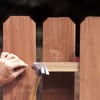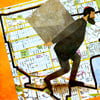An eruv (ערוב, pronounced ay-roov), in modern terminology, is a technical boundary that allows Jews to carry in public areas on Shabbat. It is one of those traditions which has blossomed from a basic Torah principle into a highly complicated legal matter. The eruv has resulted in a growing body of interest throughout the world, and the establishment of organizations to carry it out. Some of these corporations have their own websites. There are eruvs ("eruvim" in Hebrew) all the way from Richmond, Virginia, to Gibraltar to Toronto to Melbourne, Australia, to Tel Aviv.
The literal meaning of the word eruv is blending or intermingling, but that really does not tell us much. The concept of an eruv goes back to the principle of Shabbat rest. Under Jewish law on Shabbat, it is forbidden to carry anything—regardless of its weight, size or purpose—from a "private" domain into a "public" one or vice versa, or more than four cubits (approximately 6 feet) within a public domain. Private and public do not refer to ownership, rather to the nature of the area. An enclosed area is considered a private domain, whereas an open area is considered public for the purposes of these laws.
There are eruvs from Virginia to Gibraltar to Toronto to Australia to Tel AvivWhy Is an Eruv Needed?
Practically, it is forbidden to carry something, such as a tallit bag or a prayer book from one's home along the street and to a synagogue or to push a baby carriage from home to a synagogue, or to another home, on Shabbat.
It became obvious even in ancient times, that on Shabbat, as on other days, there are certain things people wish to carry. People also want to get together with their friends after synagogue and take things with them—including their babies. They want to get together to learn, to socialize and to be a community.
Given the design of many communities in the past, many neighborhoods or even cities were walled. As such, the whole area was regarded as "private," and carrying allowed. That, however, wasn’t always the case. And today, it is an obvious impracticality to build walls throughout portions of cities, crossing over or through streets and walkways, in order to place one's home and synagogue within the same "private" domain.
The Answer Is the Eruv
The answer is a technical enclosure which surrounds both private and hitherto public domains and thus creates a large private domain in which carrying is permitted on Shabbat. Colloquially this is known as an eruv.1 The eruv is usually large enough to include entire neighborhoods with homes, apartments and synagogues, making it possible to carry on Shabbat, since one is never leaving one's domain.
A wall can be a wall even if it has many doorways creating large open spacesIt is technical, because theoretically the eruv should be a wall. However, a wall can be a wall even if it has many doorways creating large open spaces. This means that a wall does not have to be solid. Therefore, the eruv enclosure may be created by telephone poles, for example, which act as the vertical part of a door post in a wall, with the existing cables strung between the poles acting as the lintel of the doorframe. As such, the entire "wall" is actually a series of "doorways." Added to that there may be existing natural boundaries and fences.2
What You Can Carry and What You Cannot
An eruv does not give one a license to carry everything. It does not allow the carrying of objects whose use is forbidden on Shabbat (See The Shabbat Laws for more on this topic). For example, it is forbidden to carry an umbrella since opening or closing it is forbidden.3 Therefore, an umbrella cannot be carried anywhere on Shabbat regardless of whether it is within the eruv or not. Pens cannot be carried within the eruv, since pens cannot be carried on Shabbat at all. Finally, items which will only be used after Shabbat also cannot be carried on Shabbat, even within the eruv.
The purpose of the eruv is to allow certain basic necessities to be carried, such as a tallit or a prayer book, house keys, clothing which is removed on warm days, and reading glasses. And it allows the pushing of a baby carriage along with food and diapers.
The Eruv vs. the Law
Part of the fascination in the erection and study of eruvs lies outside Talmudic and rabbinic literature. It lies in the secular world of law and lawsuits. Numerous lawsuits have arisen in various parts of the world involving eruvs. These cases usually involve municipal by-laws and regulations.
In the city of Outremont in the Canadian Province of Quebec, a number of Orthodox Jews asked their city council for permission to build an eruv. The city council lead by its Jewish mayor refused even though about one quarter of the city's population was Jewish. A non-Jewish judge overruled the city, noting that the Canadian Charter of Rights and Freedoms guarantees that religion can be practiced openly. Cases have also arisen in the United States and other countries.
The Washington D.C. eruv includes the White HouseDespite these problems, the construction of eruvs continues in many parts of the world. The Washington D.C. eruv includes the White House. The Strasbourg eruv includes the European Court of Human Rights.
How to Use an Eruv
Because the eruv must remain in good repair in order to effectively carry out its role, organizations that maintain an eruv usually have a telephone number or a website where anyone who wants to make use of the eruv may find out if the eruv is in working order, that there are no breaks in it and that it is operational.
In most cases, the eruv operators inspect it every week to make certain that it is "operational." If any part of the eruv has come down, attempts must be made to make repairs before Shabbat. If this cannot be done, the effectiveness of the eruv is lost, since the area is no longer enclosed by a continuous boundary.
Concerns About the Eruv
While there are an increasing number of eruvs being established throughout the world in traditional Jewish communities, support for the practice is not universal.
There is the concern that if there is an eruv in a community, those who rely on it may very easily forget when they travel to communities without an eruv, and carry on Shabbat.
A second concern is that if the eruv breaks during Shabbat, no one will know. As a result, they will conduct themselves as if there still is a functioning eruv, this breaking the rules of Shabbat.
It is imperative that an expert rabbi oversee the construction of any eruvThe final and perhaps the major concern is that because an eruv allows an exception to the prohibition against carrying on Shabbat, it is quite natural for anyone regularly using an eruv to forget that this is an exception; forgetting that there is a prohibition against carrying on Shabbat.4
Technical Notes
Construction of an eruv is one of the most abstruse areas of Jewish law. An enormous amount of material has been written on the subject and the Talmud dedicates an entire tractate to it. Just because a particular area is enclosed by telephone poles and wires is not sufficient reason to allow carrying within that area. Many areas cannot be included in an eruv, and many telephone poles do not qualify—for reasons beyond the scope of this article.
Furthermore, whenever an eruv includes multiple residences, in addition to the physical (or technical) enclosure encompassing the area, the inhabitants of the eruv must also be "conjoined" into one entity through the joint ownership of some food (See Eruv for more on this topic).5
For all these reasons, it is imperative that an expert rabbi oversee the construction of any eruv.











Join the Discussion